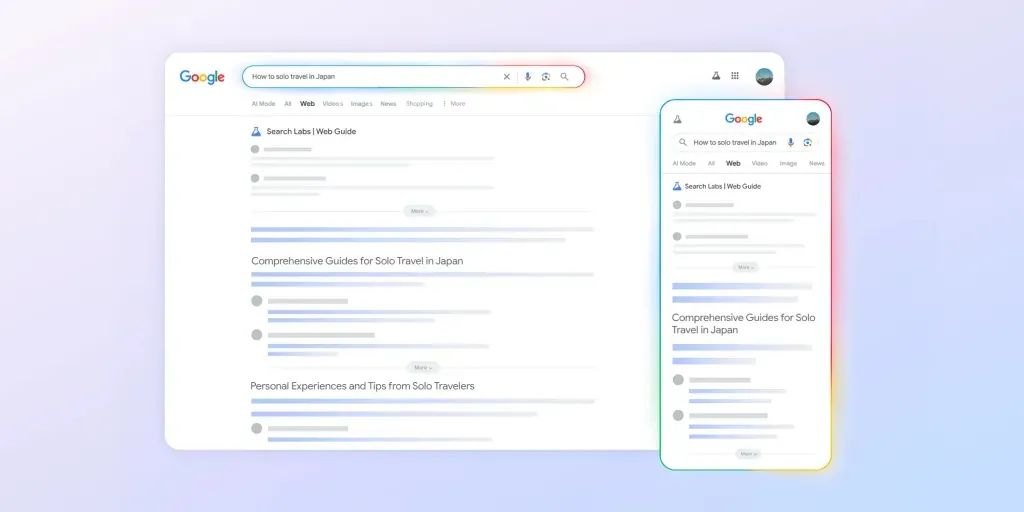Google’s Web Guide: How AI Is Reshaping Search Results

Google has introduced a new AI-powered experiment called Web Guide. Once enabled via Search Labs, Web Guide restructures the traditional search experience by grouping results into AI-curated topic clusters. It represents a major shift in how users interact with search results and how businesses should think about content visibility.
What Is Web Guide?
Web Guide is part of Google’s experimental features available in Search Labs:
- It uses a custom Gemini AI model to reorganize search results
- Breaks down broad queries into sub-intents using multi-query fan-out
- Clusters web pages into categorized themes
- Applies only to the Web tab and can be disabled anytime
Instead of showing a traditional ranked list, Web Guide presents logically grouped results that reflect multiple angles of a search query.
How Web Guide Differs From Other AI Features
| Feature | Web Guide | AI Overviews | AI Mode |
|---|---|---|---|
| Output | Grouped links | AI-generated summary | Conversational answers |
| Access | Search Labs (Web) | Default on many queries | Labs (gradual rollout) |
| Structure | Visual categories | Paragraph text | Interactive agent |
Web Guide doesn’t summarize content or replace traditional search — it reshapes how users discover and navigate the results.
Why This Matters for SEO and Visibility
The introduction of Web Guide represents a broader shift in how content is surfaced:
1. Ranking Is No Longer Linear
Search results are no longer strictly ordered. Pages may appear in a relevant cluster regardless of their original position.
2. User Click Behavior Is Changing
Instead of scanning a list, users explore grouped topics. This lowers the click-through rate of top-ranked results and rewards contextual relevance.
3. Content Needs Structural Depth
Pages that lack comprehensive coverage of a topic may not qualify for inclusion in AI-generated clusters, regardless of their SEO strength.
How to Prepare Your Content Strategy
To ensure visibility in this new search paradigm, businesses should:
Build Rich Topic Coverage
Cover multiple sub-intents within a single article or create tightly-linked clusters of related content.
Use Clear Headings and Subsections
AI relies on headings to interpret meaning. Your H2s and H3s should reflect real search intent (e.g. “Use Cases,” “Pricing in Europe,” “Step-by-Step Guide”).
Add Structured Data
Implement schema types like FAQPage, ItemList, and HowTo. These improve machine readability and clustering potential.
Create AI-Friendly Content Blocks
Think in terms of extractable chunks. Define terms, list options, and explain benefits in scannable formats.
Monitor Server Logs
With AI-overview and clustering features growing, many user journeys now go untracked by Google Analytics. Use server logs to see true origin traffic, especially from AI bots like Perplexity or ChatGPT.
Actionable Next Steps for Businesses
- Enable Web Guide via Search Labs and search your own topics
- Analyze whether your pages appear in any groupings
- Expand underperforming content to address more dimensions
- Link from high-authority pages to topical clusters within your domain
- Build evergreen content that answers layered queries across use cases, regions, and verticals
What Google’s Strategy Tells Us About the Future
Google’s shift toward structured, AI-curated SERPs indicates long-term priorities:
- Structured content will increasingly outperform shallow SEO
- Brands need to prepare for declining CTR even on high-ranking pages
- AI-optimized discovery will continue to expand, especially via Gemini and SGE integrations
Want Help Navigating the AI-Driven Future of Search?
At Scalevise, we help businesses rethink their digital visibility by building systems that align with how AI organizes, interprets, and surfaces content.
Explore how we use agentic AI and middleware automation to future-proof our clients’ infrastructure and SEO strategies.
Ready to take the next step?
Contact our team and discover what your business needs to stay ahead.
Try the Sales Agent Now
